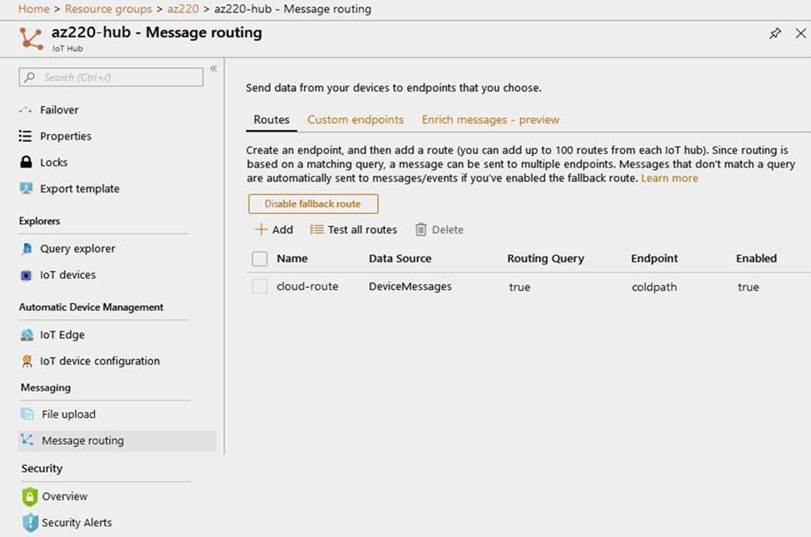3. Topic 2, ADatum
Case Study
This is a case study. Case studies are not timed separately. You can use as much exam time as you would like to complete each case . However, there may be additional case studies and sections on this exam. You must manage your time to ensure that you are able to complete all questions included on this exam in the time provided.
To answer the questions included in a case study, you will need to reference information that is provided in the case study. Case studies might contain exhibits and other resources that provide more information about the scenario that is described in the case study. Each question is independent of the other question on this case study.
At the end of this case study, a review screen will appear. This screen allows you to review your answers and to make changes before you move to the next sections of the exam. After you begin a new section, you cannot return to this section.
To start the case study
To display the first question on this case study, click the Next button. Use the buttons in the left pane to explore the content of the case study before you answer the questions. Clicking these buttons displays information such as business requirements, existing environment, and problem statements. If the case study has an All Information tab, note that the information displayed is identical to the information displayed on the subsequent tabs. When you are ready to answer a question, click the Question button to return to the question.
Requirements. Planned Changes
ADatum is developing an Azure IoT solution to monitor environmental conditions. The IoT solution consists of hardware devices and cloud services. All the devices will communicate directly to Azure IoT Hub.
The hardware devices will be deployed to the branch offices and will collect data about various environmental conditions such as temperature, humidity, air quality, and noise level. The devices will be wired by using Power over Ethernet (PoE) connections.
ADatum is developing the solution in the following three phases: proof of value (POV), pilot, and production.
Requirements. POV Requirements
The POV phase will demonstrate that a technical solution is viable. During this phase, 100 devices will be deployed to the main office and Azure Stream Analytics will be connected to an IoT hub to generate real-time alerts.
Stream Analytics will perform the following processing:
- Calculate the median rate of the telemetry across the entire devices that exceed the median rate by a factor of 4.
- Compare the current telemetry to the specified thresholds and issue alerts when telemetry values are out of range.
- Ensure that all message content during this phase is human readable to simplify debugging.
Requirements. Pilot Requirements
During the pilot phase, devices will be deployed to 10 offices. Each office will have up to 1,000 devices.
During this phase, you will add Azure Time Series Insights in parallel to Stream Analytics to support real-time graphs and queries in a dashboard web app.
The pilot deployment must minimize operating costs.
Requirements. Production Requirements
The production phase will include all the offices.
The production deployment will have one IoT hub in each Azure region. Devices must connect to the IoT hub in their region.
The production phase must meet the following requirements:
- Ensure that the IoT solution can support performance and scale targets.
- Ensure that the IoT solution support up to 1,000 devices per office.
- Minimize operating costs of the IoT solution.
Requirements. Technical Requirements
Datum identifies the following requirements for the planned IoT solution:
- The solution must generate real-time alerts when a fire condition is detected in an office. All the devices in that office must trigger an audible alarm siren within 10 seconds of the alert.
- A dashboard UI must display alerts and the system status in real time and must allow device operators to make adjustments to the system.
- Each device will send hourly updates to IoT Hub. Condition alerts will be sent immediately.
- Multiple types of devices will collect telemetry that has different schemas.
- IoT Hub must perform message routing based on the message body.
- Direct methods must be used for cloud-to-device communication.
- Reports must be provided monthly, quarterly, and annually.
- Stored data queries must be as efficient as possible.
- The device message size will be under 4 KB.
- Development effort must be minimized.
Requirements. Throttle and Quotas
The relevant throttles and quotas for various IoT Hub tiers are shown in the following table.

Requirements. IoT Hub Routing
You plan to implement IoT Hub routing during the POV phase as shown in the following exhibit.

During the POV phase, telemetry from IoT Hub stops flowing to the hot path. The cold path continues to work.
What should you do to restore the hot path?
